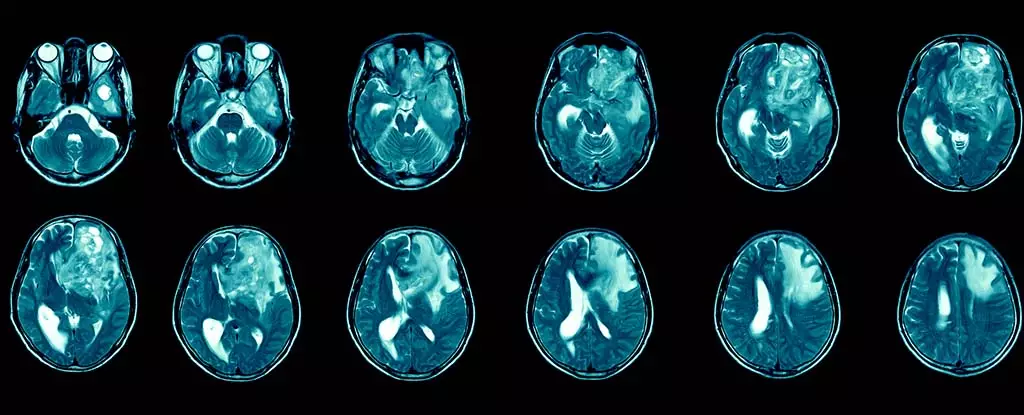Glioblastoma, often referred to as GBM, is considered one of the most formidable adversaries in the realm of oncological diseases. This alarming type of brain cancer is not only the most prevalent but also one of the deadliest, with an average life expectancy of merely 12 to 15 months post-diagnosis. The survival rate is chillingly low; only about 6.9% of patients manage to survive beyond five years. The grim statistics surrounding glioblastoma highlight the disease’s aggressive nature, classifying it as a grade 4 tumor by the World Health Organization. Each year in the UK alone, approximately 3,200 individuals receive a glioblastoma diagnosis, contributing to a total of around 12,700 cases of brain and central nervous system tumors reported annually.
However, the dire consequences of glioblastoma extend far beyond mere survival rates. Patients often endure a multitude of debilitating symptoms that can include severe headaches, seizures, and significant cognitive and personality changes. Consequently, the quality of life for these patients is significantly compromised, leading to a pressing need for more effective treatment options. Unfortunately, current treatment methodologies, which primarily include surgical intervention, radiation therapy, and chemotherapy, frequently yield only temporary respite. The unique characteristics of glioblastoma further complicate treatment, as these tumors exhibit remarkable resistance to conventional therapies, largely due to their immuno-suppressive capabilities and the formidable blood-brain barrier that hampers drug efficacy.
The Promise of Immunotherapy
In the face of an urgent need for effective glioblastoma treatments, immunotherapy emerges as a potential game-changer. This innovative treatment strategy endeavors to leverage the body’s own immune system to identify and combat cancer cells. While the concept has shown incredible success in treating other cancer types, such as melanoma and lung cancer, glioblastoma still presents considerable challenges due to its highly adaptable and heterogeneous nature. This can lead to the presence of a variety of mutations within different regions of the same tumor, making it incredibly complex to target effectively.
However, recent advances in the field of immunotherapy have sparked optimism. For instance, early clinical trials have shown that innovative delivery methods, such as injecting treatments directly into the cerebrospinal fluid, can significantly improve safety and efficacy. Ongoing research is keenly focused on optimizing these methods to ensure that therapeutic agents can penetrate glioblastomas more effectively than ever before. Still, the pathway to successfully implementing immunotherapy for glioblastoma patients remains fraught with obstacles, highlighting the urgent need for further innovation in this area.
Despite the promise that immunotherapy holds, funding limitations have long hindered research efforts specifically targeting glioblastoma. Nonetheless, a new wave of initiatives is emerging, aimed at attracting researchers from diverse fields to the challenge of understanding and treating this daunting disease. As one such researcher, my own background has involved studying the immune system’s interactions during cancer and chronic infections for over two decades. More recently, I have turned my focus to the communication between immune cells and brain function, investigating how these interactions could influence the onset of conditions such as Alzheimer’s disease.
In my current exploration of glioblastoma, I aim to apply my extensive knowledge to surpass the barriers that currently obstruct effective treatment delivery. My research is part of an international collaboration focused on validating immunotherapy strategies specifically for glioblastoma. This effort is crucial, as the development of an effective immunotherapeutic approach could dramatically alter the treatment landscape for patients.
Despite the excitement surrounding immunotherapy’s potential, it is essential to acknowledge that not all cancer types react favorably to this treatment modality. There also exists a risk of immune-related adverse effects, including dangerous inflammation of the organs. Thus, it becomes imperative to carefully assess the required treatment strategies to ensure that there is minimal risk of complications, such as cerebral edema or swelling.
Furthermore, the delivery method plays a critical role in the administration of the therapy. The convenience of an injection into the bloodstream or spinal fluid is vastly preferable to the invasiveness of neurosurgery. This highlights the significance of refining administration techniques to enhance both patient comfort and treatment outcomes.
Looking to the future, the prospects of immunotherapy in glioblastoma treatment remain tantalizingly close. With growing interest and investment in this field, the hope is that continued research will lead to the discovery of more effective treatments, ultimately improving outcomes for those grappling with this devastating disease. The journey is arduous, but the determination of researchers worldwide continues to fuel the pursuit of a brighter and healthier future for glioblastoma patients.


Leave a Reply